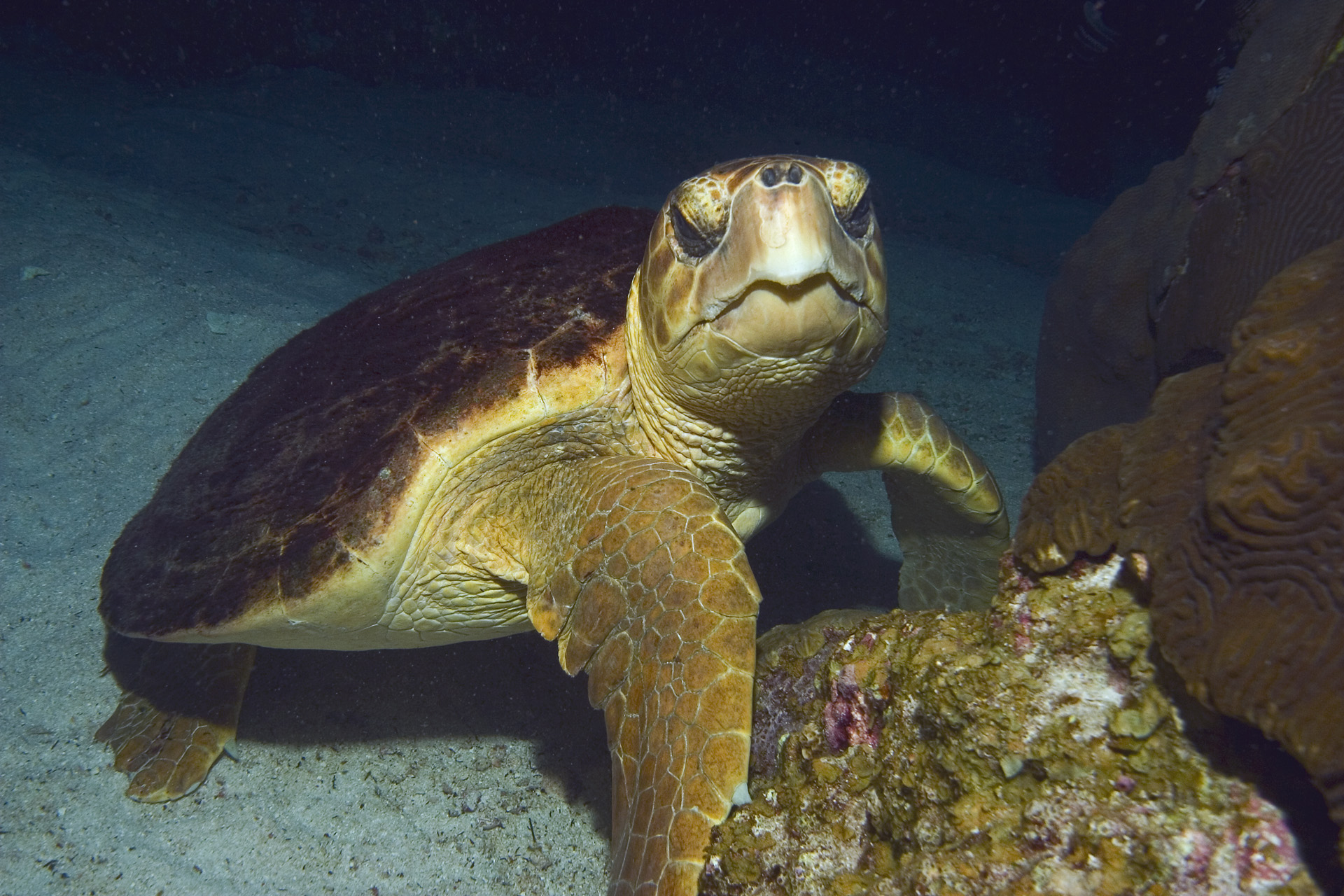Form and Function
One aspect that is essential in gaining a better understanding
of an organism is their form and function. The loggerhead sea turtle is the largest hard-shelled turtle in
the world. Adult turtles tend to grow to be around 3 feet long
and weigh approximately 200 pounds (U.S. Fish and Wildlife
Service, 2013). Distinctive characteristics
include the turtle’s large head and extremely strong jaws used
to crush hard shelled prey (MarineBio, 2014). An interesting
fact about the loggerhead turtle's head is that it can't be
withdrawn like many other turtle's can. But to make sure their
head is still well protected, the Caretta caretta have very
thick and scaly skin covering both their head and neck
(MarineBio, 2014). A turtle's coloring and shell shape is also
unique to the species. The loggerhead underbellies, also known as
plastron, are usually a monochromatic yellow color. The turtle’s
heart-shaped shells, also known as carapace, tend to have a
red/brown coloring (Department of Energy and Environmental
Protection, 2013). It is important to note that a turtle’s
shell is not an exoskeleton; it is actually a bony covering and
a source of protection to the dorsal area of the turtle
(MarineBio, 2014). Parts
of the epidermal layer of the shell are the scutes, or ridges,
on the shell (U.S. Fish and Wildlife Service, 2013). Turtles are motile animals in both water and on
land by use of their four flippers. In fact, they can swim up to 24 kph since their flippers
are designed similar to paddles used in a rowboat (MarineBio,
2014).
Loggerhead
turtles spend a majority of their time in water; in fact they
spend less than 2% of their life at the surface (Lutcavage et
al., 1987). In
order to survive in these conditions, the loggerhead’s lungs have
actually adapted to spending a majority of their time
underwater. Their lungs are divided in to multiple chambers,
which provides them with a larger surface area for gas exchange. Their increase of gas exchange
allows for a higher intake of oxygen (Lutcavage et al., 1987).
Loggerhead turtles actually store and transport their oxygen for
when they are submerged for long periods of time, which
minimizes the amount of times they need to go up to the surface
for air. The stored oxygen is mostly used to supply their brain,
heart and lungs while the rest of their body undergoes anaerobic
respiration; meaning they undergo cellular respiration without
oxygen (Lutcavage et al., 1987). Loggerhead turtles will usually
dive for four to five minutes before spending only one to three
seconds on the surface for air (MarineBio, 2014). Since
loggerheads can dive to fairly deep depths, their lungs are lined
with smooth muscles and fibers. These muscles and fibers
increase the stability of the loggerhead’s lungs without hindering
the efficiency of gas exchange (Lutcavage & Lutz, 1991). Another
fascinating fact about loggerhead turtle’s diving patterns is
that their gas exchange system actually differs depending on if
their dive is voluntary or forced. If their dives are forced the
turtles they are less likely to appropriately respond, thus
possibly leading to mortality (Lutcavage et al., 1987).
surface area for gas exchange. Their increase of gas exchange
allows for a higher intake of oxygen (Lutcavage et al., 1987).
Loggerhead turtles actually store and transport their oxygen for
when they are submerged for long periods of time, which
minimizes the amount of times they need to go up to the surface
for air. The stored oxygen is mostly used to supply their brain,
heart and lungs while the rest of their body undergoes anaerobic
respiration; meaning they undergo cellular respiration without
oxygen (Lutcavage et al., 1987). Loggerhead turtles will usually
dive for four to five minutes before spending only one to three
seconds on the surface for air (MarineBio, 2014). Since
loggerheads can dive to fairly deep depths, their lungs are lined
with smooth muscles and fibers. These muscles and fibers
increase the stability of the loggerhead’s lungs without hindering
the efficiency of gas exchange (Lutcavage & Lutz, 1991). Another
fascinating fact about loggerhead turtle’s diving patterns is
that their gas exchange system actually differs depending on if
their dive is voluntary or forced. If their dives are forced the
turtles they are less likely to appropriately respond, thus
possibly leading to mortality (Lutcavage et al., 1987).
Links
Reproduction and Life History→